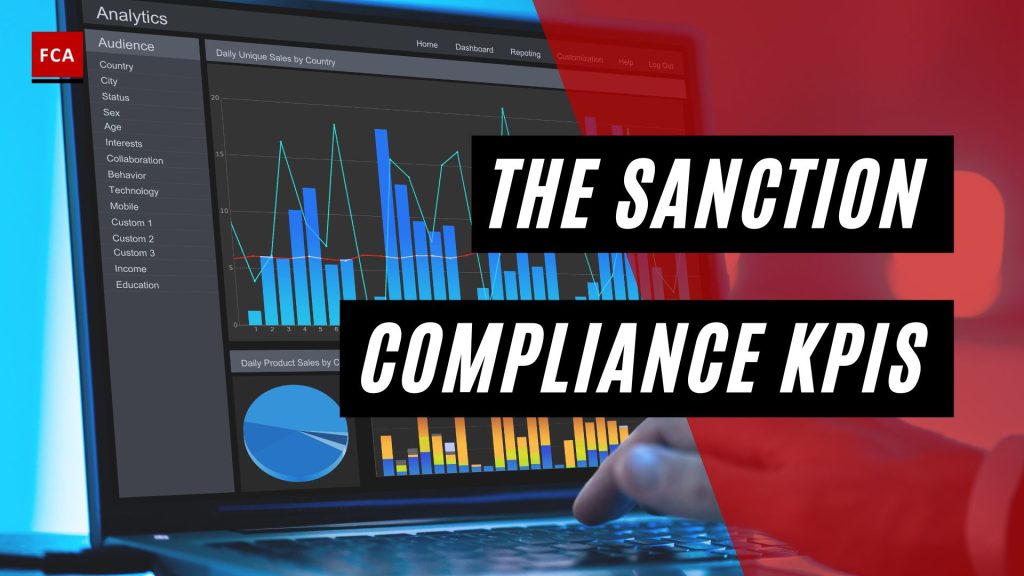The sanction compliance KPIs (Key Performance Indicators) play a pivotal role in gauging the effectiveness of an organization’s adherence to regulatory mandates. They offer quantifiable metrics that enable businesses to measure, evaluate, and enhance their sanctions compliance programs.
By regularly monitoring these KPIs, organizations can identify potential vulnerabilities, ensuring they stay ahead of any regulatory changes and avert potential non-compliance penalties. Furthermore, these indicators promote transparency and accountability, fostering a culture of due diligence and ethical conduct throughout the enterprise.
Compliance key performance indicators (KPIs), are statistics or metrics that help in measuring the compliance performance, in relation to institution’s strategic goals.
KPIs include how compliant the overall institution and its departments or processes are, in relation to its internal policies and regulatory requirements.

The Sanction Compliance KPIs
The effectiveness of the sanctions compliance program is measured against the KPIs, and they are used to monitor the compliance mitigation plans. KPIs are also used as early signals for taking appropriate sanction compliance measures, to avoid regulatory non-compliances.
Monitoring of compliance with sanctioned KPIs avoids the risks of financial, reputational and operational losses.
Measuring Sanction Compliance Rate
Sanction compliance rate is measured by taking the number of instances identified as non-compliant with applicable sanction law and regulations, and deduct the number of such instances from the total number of compliance breach instances. Then divide the remaining number by the total number of compliance breaches and multiply by 100. This will calculate the percentage of the sanction compliant rate.
Sanction Compliance Metrics and Key Performance Indicators
To identify the instances of sanction non-compliances, compliance specialists need to assess the sanction compliance risks, considering the relevant laws, regulations, policies, and procedures.
KPIs are then developed based on the results of sanction compliance risk assessments, to measure the sanction compliance rate.
To assess the sanction compliance risks, the institutions need to ensure that predictive and existing sanction compliance risks are identified for assessment purposes.
Risk analytics are used for predictive risks, and need relevant sanction compliance data points to support the risk significance, inherent and residual risk scoring and assessment results.
The lower rate of sanction compliance indicates strong sanction compliance culture and practices in the organization.
The lower rate of sanction compliance reflects the overall good performance of compliance function. However, it is mandatory that the sanction compliance rate is assessed and calculated by independent compliance specialists, who possess strong knowledge of applicable sanction laws and regulations.
KPIs include how compliant the overall institution and its departments or processes are, in relation to its internal policies and regulatory requirements.
Metrics and KPIs should have following characteristics:
Simple: Simple KPIs are developed to focus efforts and take effective decisions rather than confuse the compliance matters.
Quantitative: KPIs should include numerical data that can be tracked, such as the number of sanction compliance instances reported or identified.
Qualitative: KPI measures should reflect the effectiveness of an element of a compliance program. This may include, the sanction compliance data and breaches reported by employees as part of their job roles.
Relevant: The KPI must be relevant and matched to the relevant process or department to enable them to own the sanction compliance process.
Directional: The sanction compliance metric or KPIs should show whether the compliance status is improving on a consistent basis. Understanding the direction of sanction compliance progress helps in deciding the need to rethink and adjust compliance policies and procedures.
Specific: The specific KPI are more likely to be achieved. Concrete sanction compliance goals should be made, such as asking the internal audit team to increase the specified number of internal audits focussed on specific sanction compliance requirements, during a particular period.
The metrics and KPIs of sanction compliance include but are not limited to:
- ensuring that sanction compliance program is developed and implemented
- ensuring that sanction compliance policies and procedures are developed and implemented
- ensuring that sanction compliance laws and regulations are tracked and incorporated in compliance program and policies
- ensuring that sanction individuals and entities lists are maintained and revisited regularly for necessary amendments
- ensuring that sanction match individuals and entities are investigated appropriately, to ensure that such individuals or entities are not onboarded or terminated based on the requirements of applicable laws and regulations
- ensure that transactions are monitored appropriately on a risk-based criteria, to identify any sanction individual or entity appearing in the customer lists
- ensure that sanction training sessions are regularly provided to the employees.

Final Thoughts
Compliance key performance indicators (KPIs) play a pivotal role in evaluating an institution’s adherence to internal policies and external regulatory requirements. Serving as metrics that illuminate the efficiency and effectiveness of a compliance program, KPIs offer invaluable insights into potential gaps or strengths in sanction compliance, acting as early warning systems to preemptively address any potential non-compliance. The importance of KPIs in this domain cannot be overstated, as they offer a robust framework to protect institutions from financial, reputational, and operational setbacks.
Furthermore, sanction compliance rate metrics, derived from carefully crafted equations, offer a tangible reflection of an institution’s compliance health. When designing such KPIs, emphasis should be placed on clarity, quantifiability, relevance, directionality, and specificity, ensuring they not only measure but also guide the institution towards a fortified compliance posture.









